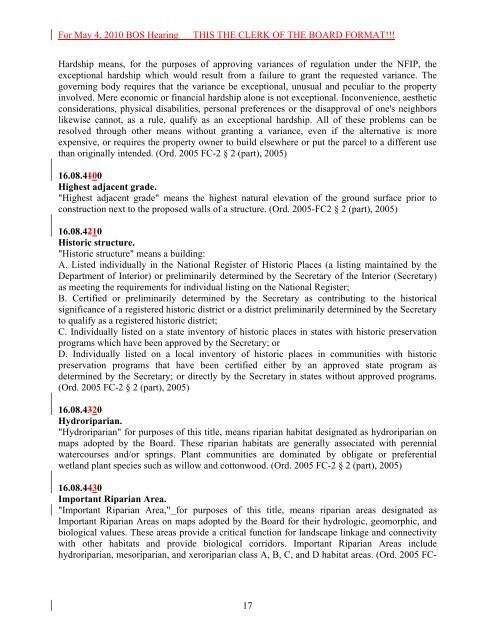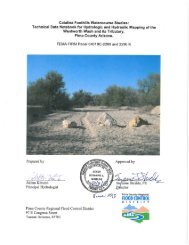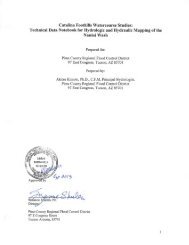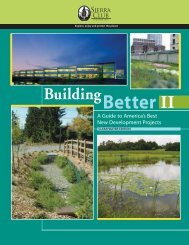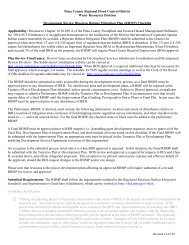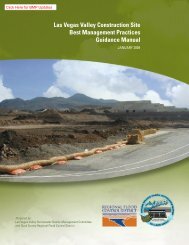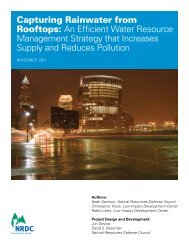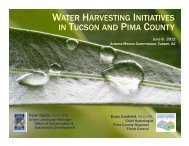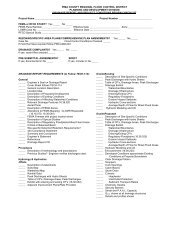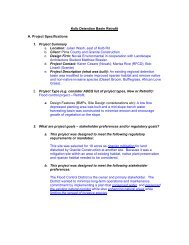For May 4, 2010 BOS HearingTHIS THE CLERK OF THE BOARD FORMAT!!!<strong>the</strong> water-surface elevation more than 1 foot above <strong>the</strong> base flood elevation under normal flowconditions;2. In addition, when geologic features confine <strong>the</strong> flow <strong>of</strong> a watercourse <strong>the</strong> following additionalareas shall be considered floodway areas:a. Areas necessary to convey <strong>the</strong> base flood without increasing <strong>the</strong> water surface elevation morethan a tenth (0.1) <strong>of</strong> a foot above <strong>the</strong> base flood elevation under normal flow conditions,b. Areas <strong>of</strong> frequent inundation as defined by <strong>the</strong> 4% annual chance (25-year) flood,c. Areas with excessive flow depths and velocities (dv 2 ), as defined in 16.26.050.G, andd. Active flow paths and channels based on <strong>the</strong> presence <strong>of</strong> unconsolidated alluvium related t<strong>of</strong>luvial processes and <strong>the</strong> potential for <strong>the</strong> flow paths to meander over time.3. A watercourse can be considered confined when <strong>the</strong> ratio <strong>of</strong> <strong>the</strong> wetted top-widths <strong>of</strong> <strong>the</strong>floodplains associated with <strong>the</strong> base flood and <strong>the</strong> 25-year flood is 1.25 or less and <strong>the</strong> height <strong>of</strong><strong>the</strong> geologic features are at least 1.5 times <strong>the</strong> hydraulic depth <strong>of</strong> <strong>the</strong> base flood. The watercourseshall be considered confined through all reaches where this criteria is present both upstream anddownstream <strong>of</strong> <strong>the</strong> subject area.C. ForThe primary channel <strong>of</strong> all regulatory minor watercourses with a 100-yearbase flood peakdischarge <strong>of</strong> less than 2,000 cfs, <strong>the</strong> floodway shall be at a minimum <strong>the</strong> primary channel;.D. For floodplain widths greater than 200 feet or for bifurcated watercourses, <strong>the</strong> floodway willbe determined by using <strong>the</strong> standards established by ADWR. (See Exhibit 16.08.310 at <strong>the</strong> end<strong>of</strong> this chapter.) (Ord. 2010 FC-1; Ord. 2005 FC-2 § 2 (part), 2005; Ord. 1999 FC-1 § 1 (part),1999; Ord. 1998 FC-1 Section 1, 1998; Ord. 1988 FC-2 Art. 4 (part), 1988)16.08.3760Floodway fringe area."Floodway fringe area" is a term used by FEMA to designate <strong>the</strong> floodplain area lying outside<strong>the</strong> floodway, but within <strong>the</strong> regulatory floodplain and below <strong>the</strong> base flood elevation. For <strong>the</strong>purposes <strong>of</strong> this title, <strong>the</strong> floodway fringe area shall also include is also <strong>the</strong> regulatory floodplainwhernever a floodway has not been defined for a regulatory watercourse. (Ord. 2010 FC-1; Ord.2005 FC-2 § 2 (part), 2005; Ord. 1999 FC-1 § 1 (part), 1999; Ord. 1988 FC-2 Art. 4 (part), 1988)16.08.3870Geologic floodplain."Geologic floodplain" means those lands adjacent to a watercourse that have been subject t<strong>of</strong>luvial processes during <strong>the</strong> Holocene epoch (i.e., approximately <strong>the</strong> past 10,000 years). Thegeologic floodplain may be different from <strong>the</strong> regulatory floodplain. (Ord. 2010 FC-1; Ord. 1999FC-1 § 1 (part), 1999; Ord. 1988 FC-2 Art. 4 (part), 1988)16.08.3980Habitat mitigation."Habitat mitigation" for purposes <strong>of</strong> Chapter 16.30 <strong>of</strong> <strong>the</strong> <strong>Pima</strong> <strong>County</strong> Code, means providing anew riparian habitat <strong>of</strong> similar quality to that which was removed as a result <strong>of</strong> physicalimprovements or development to a piece <strong>of</strong> property located within floodplain, an erosion hazardarea, or riparian habitat regulated by this <strong>ordinance</strong>. (Ord. 2005 FC-2 § 2 (part), 2005)16.08.40390Hardship.16
For May 4, 2010 BOS HearingTHIS THE CLERK OF THE BOARD FORMAT!!!Hardship means, for <strong>the</strong> purposes <strong>of</strong> approving variances <strong>of</strong> regulation under <strong>the</strong> NFIP, <strong>the</strong>exceptional hardship which would result from a failure to grant <strong>the</strong> requested variance. Thegoverning body requires that <strong>the</strong> variance be exceptional, unusual and peculiar to <strong>the</strong> propertyinvolved. Mere economic or financial hardship alone is not exceptional. Inconvenience, aes<strong>the</strong>ticconsiderations, physical disabilities, personal preferences or <strong>the</strong> disapproval <strong>of</strong> one's neighborslikewise cannot, as a rule, qualify as an exceptional hardship. All <strong>of</strong> <strong>the</strong>se problems can beresolved through o<strong>the</strong>r means without granting a variance, even if <strong>the</strong> alternative is moreexpensive, or requires <strong>the</strong> property owner to build elsewhere or put <strong>the</strong> parcel to a different usethan originally intended. (Ord. 2005 FC-2 § 2 (part), 2005)16.08.4100Highest adjacent grade."Highest adjacent grade" means <strong>the</strong> highest natural elevation <strong>of</strong> <strong>the</strong> ground surface prior toconstruction next to <strong>the</strong> proposed walls <strong>of</strong> a structure. (Ord. 2005-FC2 § 2 (part), 2005)16.08.4210Historic structure."Historic structure" means a building:A. Listed individually in <strong>the</strong> National Register <strong>of</strong> Historic Places (a listing maintained by <strong>the</strong>Department <strong>of</strong> Interior) or preliminarily determined by <strong>the</strong> Secretary <strong>of</strong> <strong>the</strong> Interior (Secretary)as meeting <strong>the</strong> requirements for individual listing on <strong>the</strong> National Register;B. Certified or preliminarily determined by <strong>the</strong> Secretary as contributing to <strong>the</strong> historicalsignificance <strong>of</strong> a registered historic district or a district preliminarily determined by <strong>the</strong> Secretaryto qualify as a registered historic district;C. Individually listed on a state inventory <strong>of</strong> historic places in states with historic preservationprograms which have been approved by <strong>the</strong> Secretary; orD. Individually listed on a local inventory <strong>of</strong> historic places in communities with historicpreservation programs that have been certified ei<strong>the</strong>r by an approved state program asdetermined by <strong>the</strong> Secretary; or directly by <strong>the</strong> Secretary in states without approved programs.(Ord. 2005 FC-2 § 2 (part), 2005)16.08.4320Hydroriparian."Hydroriparian" for purposes <strong>of</strong> this title, means riparian habitat designated as hydroriparian onmaps adopted by <strong>the</strong> Board. These riparian habitats are generally associated with perennialwatercourses and/or springs. Plant communities are dominated by obligate or preferentialwetland plant species such as willow and cottonwood. (Ord. 2005 FC-2 § 2 (part), 2005)16.08.4430Important Riparian Area."Important Riparian Area," for purposes <strong>of</strong> this title, means riparian areas designated asImportant Riparian Areas on maps adopted by <strong>the</strong> Board for <strong>the</strong>ir hydrologic, geomorphic, andbiological values. These areas provide a critical function for landscape linkage and connectivitywith o<strong>the</strong>r habitats and provide biological corridors. Important Riparian Areas includehydroriparian, mesoriparian, and xeroriparian class A, B, C, and D habitat areas. (Ord. 2005 FC-17
- Page 4 and 5: For May 4, 2010 BOS HearingTHIS THE
- Page 6 and 7: For May 4, 2010 BOS HearingTHIS THE
- Page 8 and 9: For May 4, 2010 BOS HearingTHIS THE
- Page 10 and 11: For May 4, 2010 BOS HearingTHIS THE
- Page 12 and 13: For May 4, 2010 BOS HearingTHIS THE
- Page 14 and 15: For May 4, 2010 BOS HearingTHIS THE
- Page 18 and 19: For May 4, 2010 BOS HearingTHIS THE
- Page 20 and 21: For May 4, 2010 BOS HearingTHIS THE
- Page 22 and 23: For May 4, 2010 BOS HearingTHIS THE
- Page 24 and 25: For May 4, 2010 BOS HearingTHIS THE
- Page 26 and 27: For May 4, 2010 BOS HearingTHIS THE
- Page 28 and 29: For May 4, 2010 BOS HearingTHIS THE
- Page 30 and 31: For May 4, 2010 BOS HearingTHIS THE
- Page 32 and 33: For May 4, 2010 BOS HearingTHIS THE
- Page 34: For May 4, 2010 BOS HearingTHIS THE
- Page 39 and 40: For May 4, 2010 BOS HearingTHIS THE
- Page 41 and 42: For May 4, 2010 BOS HearingTHIS THE
- Page 43 and 44: For May 4, 2010 BOS HearingTHIS THE
- Page 45 and 46: For May 4, 2010 BOS HearingTHIS THE
- Page 48 and 49: For May 4, 2010 BOS HearingTHIS THE
- Page 50 and 51: For May 4, 2010 BOS HearingTHIS THE
- Page 52 and 53: For May 4, 2010 BOS HearingTHIS THE
- Page 54 and 55: For May 4, 2010 BOS HearingTHIS THE
- Page 56 and 57: For May 4, 2010 BOS HearingTHIS THE
- Page 58 and 59: For May 4, 2010 BOS HearingTHIS THE
- Page 60 and 61: For May 4, 2010 BOS HearingTHIS THE
- Page 62 and 63: For May 4, 2010 BOS HearingTHIS THE
- Page 64 and 65: For May 4, 2010 BOS HearingTHIS THE
- Page 66 and 67:
For May 4, 2010 BOS HearingTHIS THE
- Page 68 and 69:
For May 4, 2010 BOS HearingTHIS THE
- Page 70 and 71:
For May 4, 2010 BOS HearingTHIS THE
- Page 72 and 73:
For May 4, 2010 BOS HearingTHIS THE
- Page 74 and 75:
For May 4, 2010 BOS HearingTHIS THE
- Page 76 and 77:
For May 4, 2010 BOS HearingTHIS THE
- Page 78 and 79:
For May 4, 2010 BOS HearingTHIS THE
- Page 80 and 81:
For May 4, 2010 BOS HearingTHIS THE
- Page 82 and 83:
For May 4, 2010 BOS HearingTHIS THE
- Page 84 and 85:
For May 4, 2010 BOS HearingTHIS THE
- Page 86 and 87:
For May 4, 2010 BOS HearingTHIS THE


